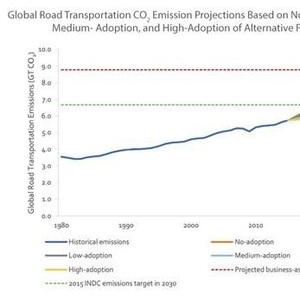Lux: Low-carbon fuels, vehicle efficiency to cut CO2 emissions

Lux Research
April 26, 2016
BY Lux Research
Global road transportation accounts for a sixth of all global carbon dioxide (CO2) emissions—and its share is rising, making it a key target for emission cuts to fight climate change. A new analysis from Lux Research finds that the emergence of low-carbon fuels and vehicle efficiency will cut emissions by 29 percent in 2030.
The sharp cut—exceeding the Intended Nationally Determined Contributions target of 24 percent set by 188 nations at the Paris Conference of the Parties (COP21) in 2015—will be realized from a combination of low-carbon fuels, alternative fuel vehicles, and improved fuel efficiencies.
“Global warming remains at center stage, and significant strides need to be made in road transportation technologies to achieve the goal set for 2030,” said Yuan-Sheng Yu, Lux Research Analyst and lead author of the report titled, “Driving Down Emissions: Achieving CO2 Emissions Reduction Goals through Biofuels and Alternative Fuel Vehicles.”
Advertisement
Advertisement
“Low-carbon biofuels like cellulosic ethanol, renewable diesel, and biomethane have lower well-to-wheel carbon intensities compared to their first-generation counterparts and play a pivotal role in cutting emissions, as does renewable electricity,” he added.
Lux Research evaluated measures needed to meet emission targets set at COP21. Among their findings:
Biofuels are key. First-generation biofuels, low-carbon fuels, and natural gas vehicles will together account for at least 45.4 percent of the potential fossil fuel displacement in road transportation in 2030, when global road transportation demand is projected to reach 911 billion gallons.
Carbon intensity matters. First-generation biofuels have made incremental reductions in road transportation emissions over the years. But low-carbon biofuels will be the key driver in achieving 2030 emissions reduction goals with an average three to four times lower well-to-wheel carbon intensity profile.
Advertisement
Advertisement
Fuel efficiency counts. Without improved fuel efficiencies, emissions reduction falls short of the INDC target in 2030 by nearly 5 percent. Automobile makers will have a range of lightweight materials available as multinationals and start-ups develop the next-generations of steel, aluminum and composite technologies.
The report, titled “Driving Down Emissions: Achieving CO2 Emissions Reduction Goals through Biofuels and Alternative Fuel Vehicles,” is part of the Lux Research Alternative Fuels Intelligence service.
Related Stories
The U.S. Department of Energy’s Office of Energy Efficiency and Renewable Energy is soliciting public comments on a preliminary plan for determining provisional emissions rates (PER) for the purposes of the 45Z clean fuel production credit.
On July 17, Iowa’s cost-share Renewable Fuels Infrastructure Program awarded $1.12 million in grants for 20 applicants to add B11 and 4 applicants to add E15 to retail sites. This was the first meeting following the start of RFIP’s fiscal year.
Par Pacific Holdings Inc., Mitsubishi Corp. and ENEOS Corp. on July 21 announced the signing of definitive agreements to establish Hawaii Renewables LLC, a joint venture to produce renewable fuels at Par Pacific’s refinery in Kapolei Hawaii.
A new study published by the ABFA finds that the U.S. EPA’s proposal to cut the RIN by 50% for fuels made from foreign feedstocks, as part of its 2026 and 2027 RVOs, could stall the growth of the biomass-based diesel (BBD) industry.
Reps. Mike Flood, R-Neb., and Troy A. Carter, Sr., D-La., on July 21 reintroduced the SAF Information Act. The bill directs the U.S. EIA to more explicitly include SAF data in its weekly and monthly reports.
Upcoming Events










